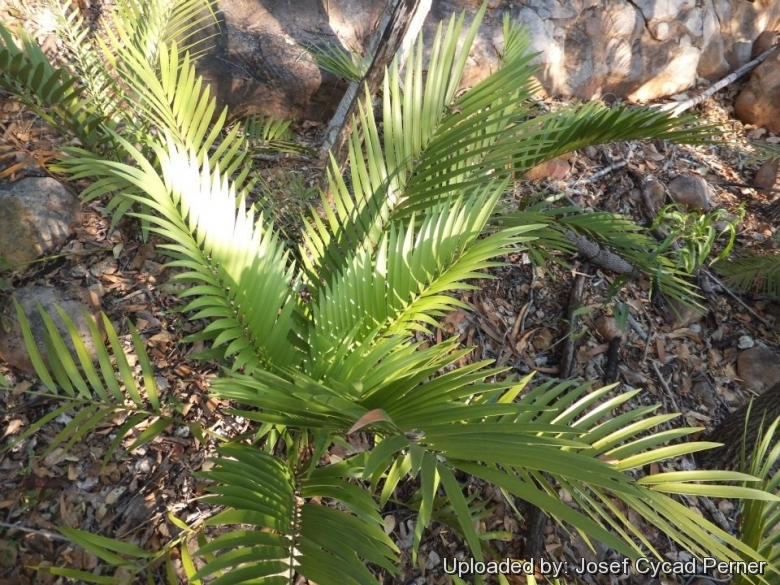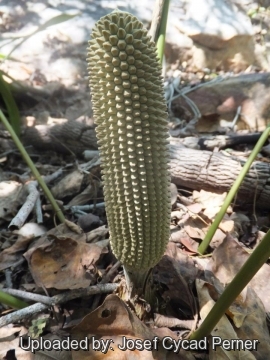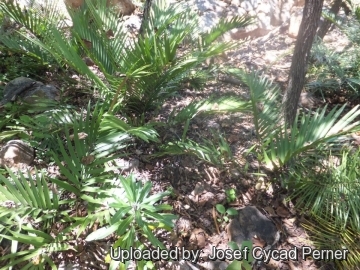




Your support is critical to our success.

Habit in Jurassic Cycad Gardens.
Origin and Habitat: Zamia encephalartoidesSN|31845]]SN|31845]] is endemic to Colombia, where it is present in the province of Santander. Plants are found near Rio Chicamocha and Rio Umpala. This species is known from 2 localities with only scattered plants in one locality (known extent of occurrence about 266 km², but the number of locations is not known ). One of the largest subpopulations near Umpala comprises about 1,000 large plants. Overall population size is estimated to be about 5,000.
Habitat and Ecology: Z. encephalartoides grows in open situations in scrubby forest on slopes of steep very hot and dry canyons and ridges carved into the Eastern Andes of Colombia by the Chicamocha River. The hot, dry, rocky and open landscape where it grows is quite different from that of other Colombian Zamia, which typically grow in humid forests. Zamia encephalartoidesSN|31845]]SN|31845]] is remarkably adapted to this arid environment. The tropical dry forest ecosystem in which it occurs is one of the mast fragmented, degraded and poorly understood ecosystems in Colombia. Eexpanding agriculture and other human activities are rapidly reducing the number of known plants. Some sites are severely eroded.
Synonyms:
- Zamia encephalartoides D.W.Stev.
SPANISH (Español): Cacao Del Indio
Description: Zamia encephalartoidesSN|28510]]SN|31845]] is a very rare arborescent cycad, that produces a medium to large sized trunk up to 2 metres in height, about 20 cm in diameter with tough, highly arched leaves to 1 metre long. The leathery, bright lime-green leaflets up to 3 cm wide are sessile and have entire, strongly coriaceous, revolute margins. The large, colourful female cones (and perhaps the seeds), superficially resembles Encephalartos, an African genus that typically grows in similar dry, open environments. In fact, the name, "Zamia encephalartoides" means "Encephalartos-like Zamia". It is interesting that the petioles are smooth (essentially free of spines), unlike many other Zamia species. This unique cycad species was described by Dennis Stevenson only on 2001, and has not been studied extensively. But it was first collected and illustrated in colour in 1783 as result of an expedition, "Real Expedicit nica del Nuevo Reyno de Granada", led by Jos. Celistino Mutis. Unfortunately no specimens survive but the colour plates are extant. There is no doubt but that the seed cone illustrated there is that of Z. encephalartoides.
Cataphylls: The cataphylls (modified leaf, much reduced and thickened, serving to protect the apical meristem and produced in flushes preceding the emergence of cones or leaves) are up to 5 cm long and 2 cm wide and have a cuneate base and acuminate apex.
Stem: Up to 2 m high (or more) and 25 cm in diameter.
Leaves: About 10-15 in a crown, 0.5-1 m long. Petiole unarmed, smooth 15-25 cm long. Rachis unarmed, with 20-40 pairs of leaflets. Leaflets imbricated, sessile, lanceolate, 20-35 cm long, 1-3 cm wide (median leaflets), strongly coriaceos, base cuneate, apex acute, margin entire strongly revolute.
Male cones: Yellowish to light brown, narrowly cylindrical, 20-30 cm long, 3-5 cm in diameter. Peduncle 5-8 cm long. Microsporophyll with sterile apex formed by six facets steeply inclined, microsporangia both on the abaxial and adaxial surface of the fertile region.
Female cones: Pale brown when young, dark green when mature, cylindrical to ovoid-cylindrical, 25-40 cm long, 10-15 cm in diameter.
Seeds: White to yellowish white, 3-4 cm long, 1.5-2 cm in diameter. The sarcotesta never really becomes soft and does break down as in other Zamiaceae. The only lighter coloured seeds in the genus Zamia is otherwise seen in the epiphytic Zamia pseudoparasiticaSN|31845]]SN|28510]] that has yellow seeds (other species seeds are red or orange).
Bibliography: Major references and further lectures
1) Dennis WM. Stevenson “Monografía no. 2: Orden Cycadales” pages 40-43, Flora de Colombia, 2001
2) The Cycad Pages: “Zamia encephalartoides” Royal Botanic Gardens Sydney Written and maintained by Ken Hill 1998-2010 Maintained by Leonie Stanberg and Dennis Stevenson 2010-2012 <http://plantnet.rbgsyd.nsw.gov.au/cgi-bin/cycadpg?taxname=Zamia+encephalartoides> Web. 18 Nov. 2014.
3) Stevenson, D.W. 2010. Zamia encephalartoides. The IUCN Red List of Threatened Species 2010. Downloaded on 11 September 2015.
4) Michael Calonje and Cristina Lopez-Gallego “Cycad Conservation: Zamia encephalartoides in Colombia” Montgomery Botanical News Page 4 Spring/Summer 2011
5) Jones, David L. Cycads of the World: Ancient Plants in Today's Landscape. Washington, D.C.: Smithsonian Institution Press, 2002.
6) V.P. Singh “Gymnosperm (naked seeds plant) : structure and development” Sarup & Sons, 01 January 2006
7) PACSOA contributors "Zamia encephalartoides". In: Cycads. Palm and Cycad Societies of Australia (PACSOA). 23 November 2013 Web. 28 August 2015.

Male cone. Photo by: Josef Cycad Perner

Male cone. Photo by: Josef Cycad Perner

Zamia encephaloides group in Jurassic Cycad Gardens. Photo by: Josef Cycad Perner
The gallery now contains thousands of pictures, however it is possible to do even more. We are, of course, seeking photos of species not yet shown in the gallery but not only that, we are also looking for better pictures than those already present. Read More...
Cultivation and Propagation: Zamia encephalartoidesSN|31845]]SN|31845]] is suited to tropical regions which have a seasonally dry climate. It is easy to grow, tolerating dry periods. It is extremely slow growing, likes well draining soil, and to not be overwatered when cold. It is extremely rare in cultivation (probably because it is a rare native of Colombia, a 'difficult' place to collect plants from). It is also a highly prized cycad due to it's attractiveness as well as it's scarcity.
Growth rate: Usually very slow growing, however good conditions can speed it up. Because of its growth habit, fertilize only when terminal bud begins to swell, indicating the start of the annual growth cycle.
Exposure: It prefers bright light exposure but colour bleaches when in full sun; best with some protection from afternoon heat.
Soil: Needs a well drained spot, with deep soil, but will still thrive in less than ideal conditions.
Watering: It must not be overwatered when cold and can tolerate some drought. It is a good species for drier areas like Southern California and northern Australia. It does not like wet tropical conditions.
Maintenance: Minimal; removal of spent fronds.
Use: Landscape as cultivated perennial in warm, coastal areas; House-plant or interior-scape, as container plant in cool areas, as well very well suited to bonsai culture.
Aerosol salt tolerance: These plants are very resistant to salts.
Propagation: Seed.
| Your Actions | |
|---|---|
| Back to Zamia index | |
| Back to Zamiaceae index | |
 |
Back to Palms And Cycads Encyclopedia index |
Privacy stantement - Terms and conditions - How to cite - About us - Feedback - Donate


